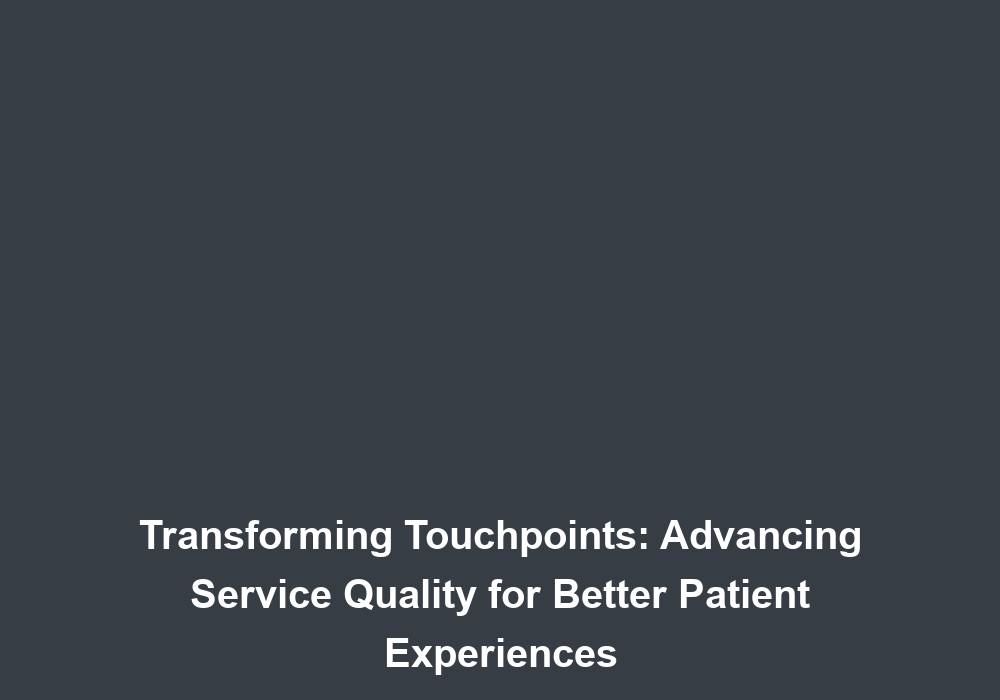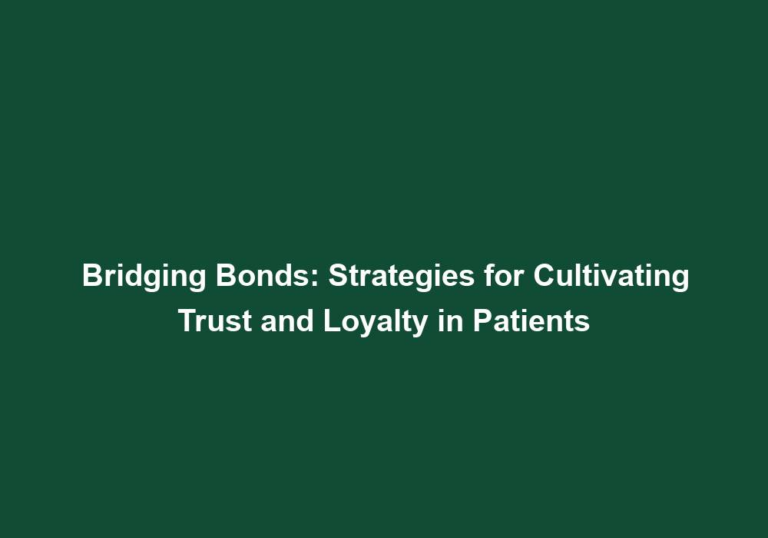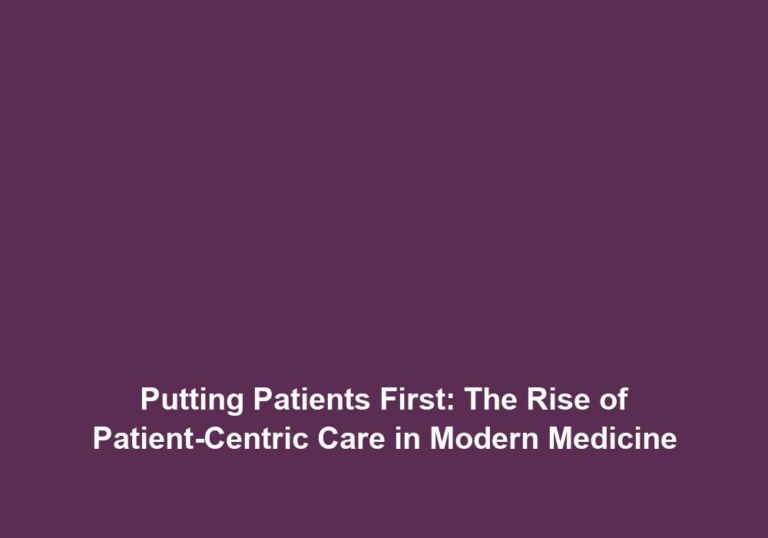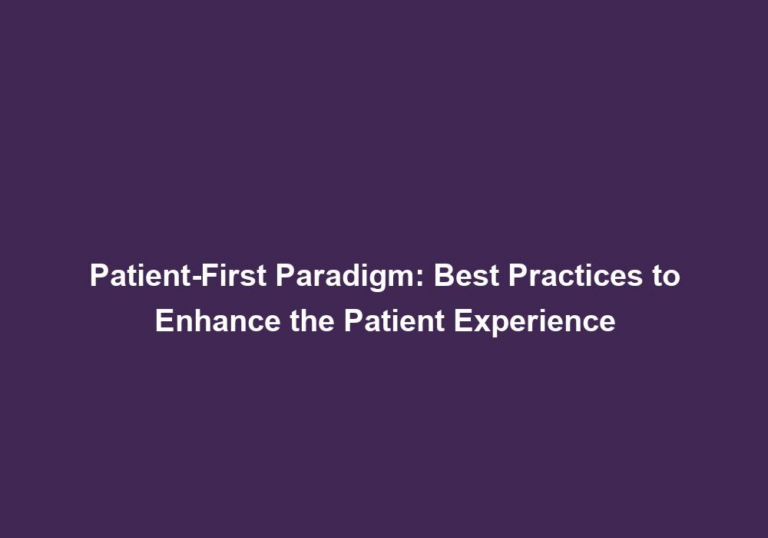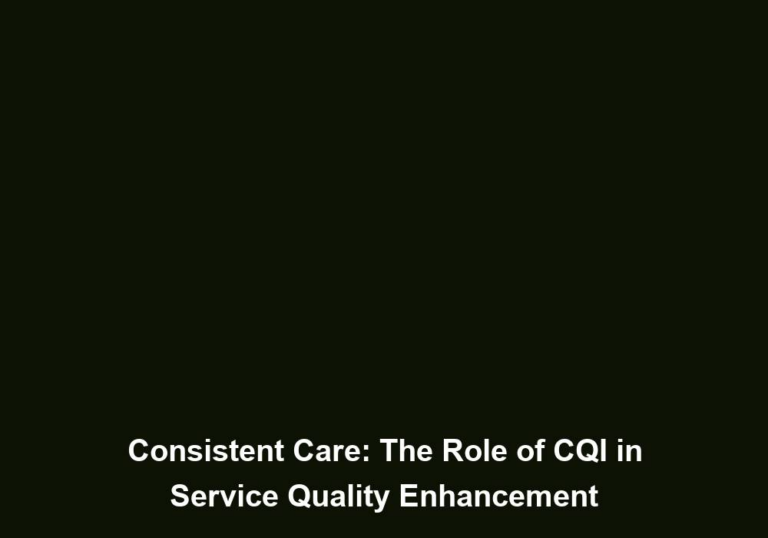Transforming Touchpoints: Advancing Service Quality for Better Patient Experiences
The healthcare industry is constantly evolving, with a growing emphasis on providing exceptional patient experiences. As healthcare providers strive to enhance service quality, one crucial aspect that cannot be overlooked is transforming touchpoints. Touchpoints refer to the various interactions patients have with healthcare professionals, facilities, and systems throughout their healthcare journey. By understanding and optimizing these touchpoints, healthcare providers can significantly improve the overall patient experience.
Importance of Transforming Touchpoints
Touchpoints play a pivotal role in shaping patients’ perceptions of healthcare services. A positive touchpoint experience can build trust, improve patient satisfaction, and foster long-term patient loyalty. Conversely, negative touchpoint encounters can lead to patient dissatisfaction, frustration, and even the loss of patients to competing healthcare providers.
To ensure a positive patient experience, healthcare providers must prioritize transforming touchpoints. This involves identifying and addressing pain points, streamlining processes, and enhancing communication and engagement at each touchpoint.
Identifying Patient Touchpoints
To effectively transform touchpoints, healthcare providers must first identify the various touchpoints patients encounter during their healthcare journey. These touchpoints can be categorized into pre-care, during-care, and post-care interactions.
Pre-Care Touchpoints
-
Appointment scheduling: The process of booking appointments is a vital touchpoint that sets the tone for the patient’s healthcare journey. Healthcare providers can enhance this touchpoint by offering convenient online appointment scheduling options, enabling patients to book appointments at their convenience. Additionally, implementing automated appointment reminders can help minimize no-shows and improve patient compliance.
-
Registration and check-in: The experience patients have when arriving at a healthcare facility is crucial in creating a positive first impression. By simplifying the registration and check-in process through the use of electronic forms and self-service kiosks, healthcare providers can reduce paperwork and waiting times, improving the overall efficiency and patient satisfaction.
-
Communication and education: Providing patients with easily accessible and comprehensive information about healthcare services, treatments, and procedures is essential. Healthcare providers can achieve this by developing user-friendly websites, informative brochures, and educational materials. Clear and concise communication channels, such as secure messaging systems or patient portals, can also facilitate timely and efficient communication between healthcare providers and patients.
-
Insurance and payment: The process of verifying insurance coverage, understanding billing procedures, and ensuring payment arrangements are in place can be overwhelming for patients. Healthcare providers can improve this touchpoint by offering transparent billing statements, clear explanations of insurance coverage, and flexible payment options. Providing financial counseling services can also help patients navigate the complexities of healthcare costs.
During-Care Touchpoints
-
Waiting room experience: The waiting room experience significantly impacts a patient’s perception of the healthcare facility. By creating a comfortable and welcoming environment with ample seating, soothing decor, and amenities like reading materials and Wi-Fi access, healthcare providers can reduce patient anxiety and improve satisfaction. Efficient scheduling systems can also minimize wait times and avoid overcrowding, ensuring patients’ time is respected.
-
Consultation and examination: The interactions patients have with healthcare professionals during consultations and examinations are critical touchpoints that influence patient satisfaction and trust. Healthcare providers should prioritize active listening, empathy, and clear explanations to foster effective communication. Thorough examinations and the involvement of patients in treatment decisions can further enhance the patient experience.
-
Medical procedures and treatments: The experience patients have during medical procedures, surgeries, or treatments can be stressful and anxiety-inducing. Healthcare providers can improve this touchpoint by implementing strategies to minimize discomfort and anxiety, such as providing detailed pre-procedure instructions, offering pain management options, and ensuring clear communication throughout the process. Additionally, ensuring the cleanliness, organization, and accessibility of healthcare facilities, including waiting areas, patient rooms, and amenities, contributes to a positive patient experience.
Post-Care Touchpoints
-
Follow-up communication: After a patient’s visit, effective follow-up communication is crucial for ensuring continuity of care and patient satisfaction. Healthcare providers should provide patients with necessary instructions, medications, or treatments promptly and clearly. Utilizing secure messaging systems or patient portals can facilitate this communication and allow patients to ask questions or seek clarifications conveniently.
-
Billing and payment: Clear and accurate billing statements and transparent payment options are essential touchpoints in the post-care phase. Healthcare providers should ensure that patients understand their billing statements, provide available payment options, and promptly address any concerns or questions related to billing or insurance. Offering billing assistance or financial counseling services can further enhance the post-care touchpoint experience.
-
Patient feedback and surveys: Actively seeking patient feedback and experiences is crucial for continuous improvement. Healthcare providers can establish mechanisms for collecting patient feedback, such as surveys, focus groups, or online reviews. By actively listening to patient concerns and suggestions and implementing necessary improvements based on the feedback received, healthcare providers can demonstrate their commitment to patient-centered care.
Strategies for Transforming Touchpoints
Once touchpoints have been identified, healthcare providers can implement various strategies to transform them and enhance the overall patient experience. Here are some effective strategies:
1. Enhance Communication and Engagement
- Foster effective communication between healthcare professionals and patients through active listening, empathy, and clear explanations. This helps to establish trust and improve patient satisfaction.
- Utilize technology to provide accessible and timely information, such as appointment reminders, test results, and educational resources. This empowers patients to be more engaged in their healthcare journey.
- Implement patient portals or secure messaging systems to facilitate communication and address patient inquiries promptly. This ensures efficient and convenient communication channels.
2. Optimize Waiting Room Experience
- Create a comfortable and welcoming waiting room environment with ample seating, soothing decor, and amenities like reading materials and Wi-Fi access. This helps to reduce patient anxiety and improve satisfaction.
- Implement efficient scheduling systems to minimize wait times and avoid overcrowding. Regular updates and effective communication of any delays or changes help manage patient expectations.
- Provide a designated staff member or a patient advocate who can offer personalized assistance and support to patients during their time in the waiting room. This enhances the overall waiting room experience.
3. Streamline Appointment Scheduling and Check-In
- Offer convenient online appointment scheduling options, enabling patients to book appointments at their convenience. This improves accessibility and convenience for patients.
- Simplify the registration and check-in process by utilizing electronic forms and self-service kiosks to reduce paperwork and waiting times. This streamlines the patient experience and enhances efficiency.
- Train staff to provide a warm and friendly welcome, ensuring patients feel valued and supported from the moment they arrive. This helps create a positive first impression and builds trust.
4. Personalize the Healthcare Experience
- Develop patient-centric care plans that consider individual preferences, needs, and values. This ensures that healthcare services are tailored to meet the unique needs of each patient.
- Empower healthcare professionals to build meaningful relationships with patients by providing adequate time for discussions and addressing concerns. This fosters trust and enhances patient satisfaction.
- Implement strategies to ensure continuity of care, including effective care transitions, interdisciplinary coordination, and communication. This helps to prevent gaps in care and improves patient outcomes.
5. Gather and Utilize Patient Feedback
- Establish mechanisms for collecting patient feedback, such as surveys, focus groups, or online reviews. This provides valuable insights into the patient experience and areas for improvement.
- Actively listen to patient concerns and suggestions, implementing necessary improvements based on the feedback received. This demonstrates a commitment to patient-centered care and continuous improvement.
- Regularly assess the patient experience to identify areas of improvement and measure the effectiveness of touchpoint transformations. This allows healthcare providers to track progress and ensure that the patient experience is consistently enhanced.
Transforming touchpoints requires a comprehensive approach, involving the collaboration of healthcare providers, administrators, and staff across various departments. By prioritizing the improvement of touchpoints, healthcare organizations can create a patient-centric culture that fosters better patient experiences, leading to improved outcomes, increased patient satisfaction, and ultimately, better outcomes for all.

